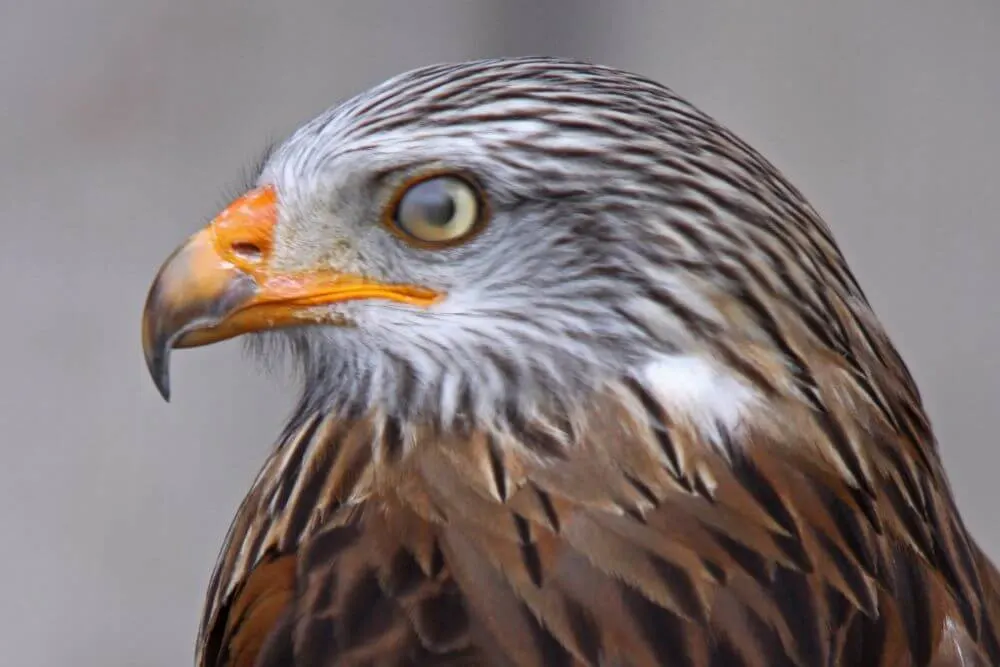
Table of Contents
- 1 Birds of Prey in Ireland
- 2 What are birds of prey?
- 3 Characteristics of Birds of Prey
- 4 Irish Birds of Prey
- 5 Falcons in Ireland
- 6 Hawks in Ireland
- 7 Harriers in Ireland
- 8 Less Common Birds of Prey in Ireland
- 9 Other Birds of Prey found in Ireland
- 10 Irish Owls
- 11 Challenges for birds of prey
- 12 Irish Bird of Prey FAQ
Birds of Prey in Ireland
Ireland’s location on the edge of Europe means that it does not have as many birds of prey as elsewhere on the continent. However, that is not to say that Ireland does not have its own magnificent native species that are found all year round in Ireland, as well as migratory visitors and the occasional “day blow in” from elsewhere.
What are birds of prey?
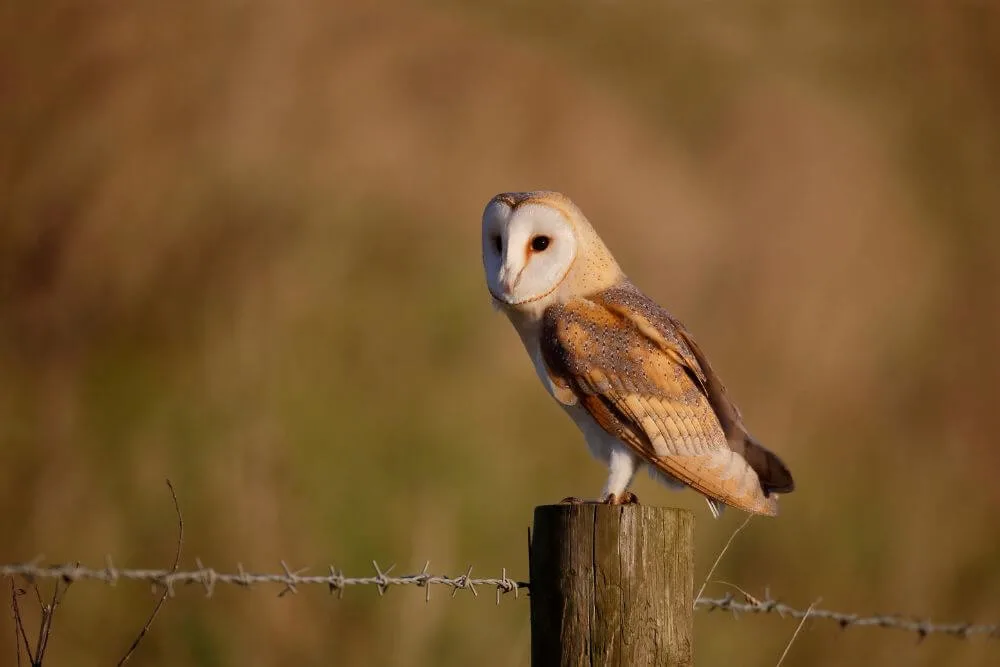
Birds of prey are predatory bird species that actively hunt and kill other vertebrate animals like small mammals (rodents, reptiles and other bird species) or sometimes even even invertebrates for food.
As apex predators, they are very important to the healthy functioning of ecosystems and play an essential role in maintaining balance within the food chain.
What is a raptor?
Birds of Prey are also commonly called raptors.
The word “raptor” is difficult to clearly define. It does not relate to closely related bird species, but is based on the Latin word “raptare” which rather describes how these predatory birds capture their food.
There is a some consensus among experts that the classification of consists of the following orders hawks and eagles (order: Accipitriformes), falcons (order: Falconiformes), owls (order: Strigiformes), New World Vultures (order: Cathartiformes) and seriemas (order: Cariamiformes).
(However, there is still some controversy relating to the inclusion of owls in the group of raptors. As owls have the characteristic traits of raptors, they will be included here.)
In Ireland, there are different species of hawks, eagles, falcons and owls which will be explored in this article.
Characteristics of Birds of Prey
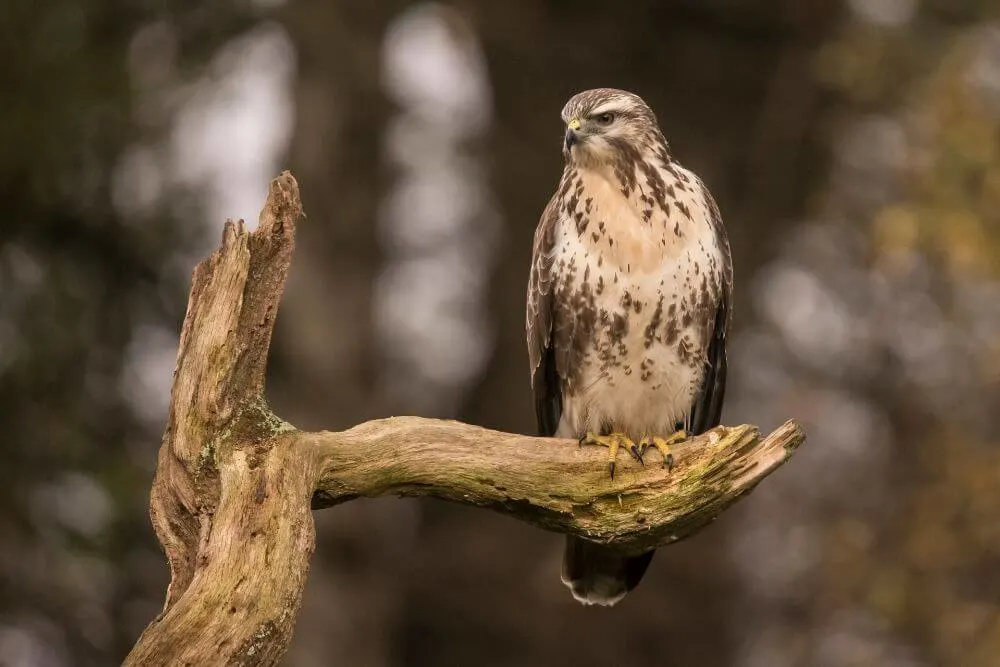
Birds of prey found in Ireland come in various different shapes and sizes. There are several characteristics that stand out about these superb predatory birds.
Some of the common characteristics of raptors include exceptionally good eyesight and hearing that enhance the birds hunting abilities, beaks which have hooked tips (useful for ripping apart flesh), strong legs and feet with sharp, curved talons for grasping, and seizing prey. Their diet is mostly carnivorous and consists of vertebrates. They often have incredible flying skills and can reach impressive speeds.
Interestingly, it is the female raptors that are generally bigger than the males in many species. This is thought to give the females a defensive advantage over males who may want to harm young chicks. The clutch size (number of eggs) is usually low.
Irish Birds of Prey
The most commonly seen birds of prey in Ireland are the Peregrine Falcon, Kestrel, Merlin, Sparrowhalk and Hen Harrier.
Falcons in Ireland
Peregrine Falcon Ireland
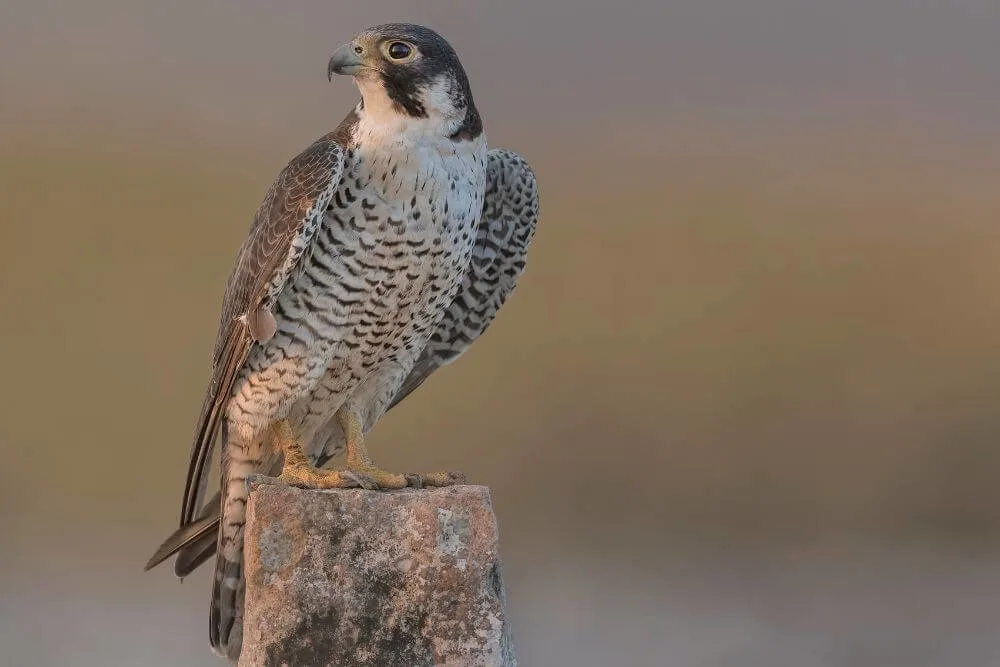
Irish Name: Fabhcún gorm
Latin Name: Falco peregrinus
Conservation Status: Green
The Peregrine Falcon is known for its hunting stealth and holds the record title of being the fastest bird in the world for diving otherwise known as stooping.
When stooping, these magnificent birds pull in their wings close to their bodies and dive at incredible speeds of up to 320 kmh (ca. 199 mph) when attacking their unsuspecting prey. The force of the impact is usually enough to kill the prey, which tends to be pigeons, collared doves, waterfowl, seagulls. These birds catch their prey in the air and tend to avoid water.
Males and females differ in size, with the females being larger. There are no major differences in the plumage coloring of the both sexes. Above the Peregrine Falcon has blue-gray color and below it is white with dark bars. The head has a black hooded appearance with clear mustache marks identifiable against the white throat. Yellow is seen on the feet, parts of the beak and the rim around the eyes.
Peregrine Falcon in Ireland
These birds are found throughout Ireland, but can often be found near coastal areas, due to the availability of waterfowl. Peregrine Falcon nests are usually built on cliff sides or occasionally in quarries.
Numbers of these raptors fell considerably due to pesticides poisonings in the 1950s and 1960s, but numbers are now recovering. (See more in the Challenges to Birds of Prey in Ireland section below).
Kestrel Ireland
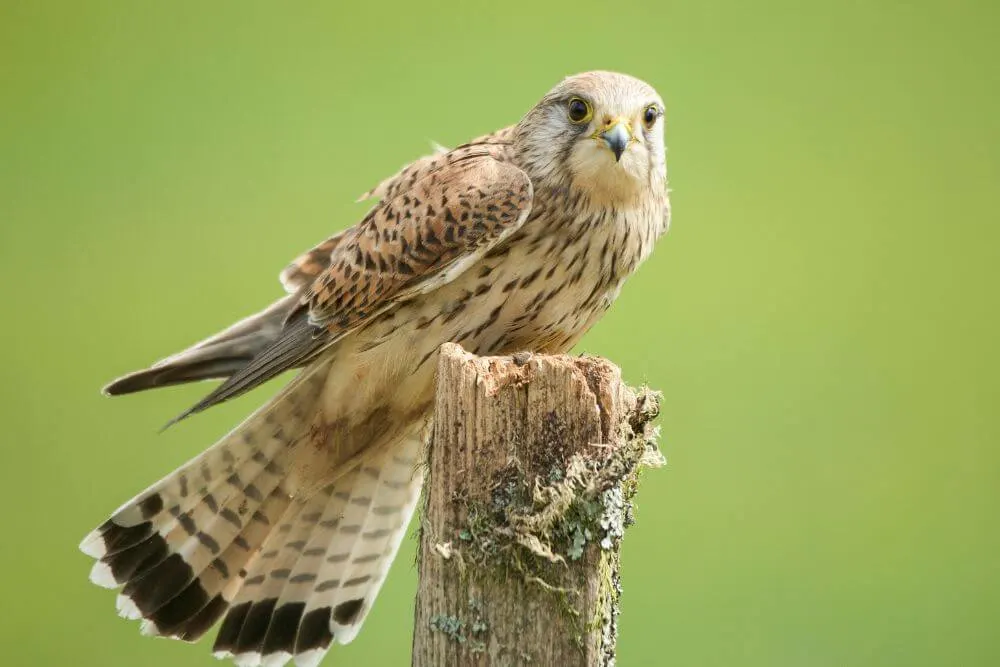
Irish Name: Pocaire gaoithe
Latin Name: Falco tinnunculus
Conservation Status: Red
The most common of Irish birds of prey is the Kestrel. In Irish, their name is Pocaire Gaoithe can be translated as “Wind Froliker”. This stems from its flying habit that makes them one of the most easy to identify in the air.
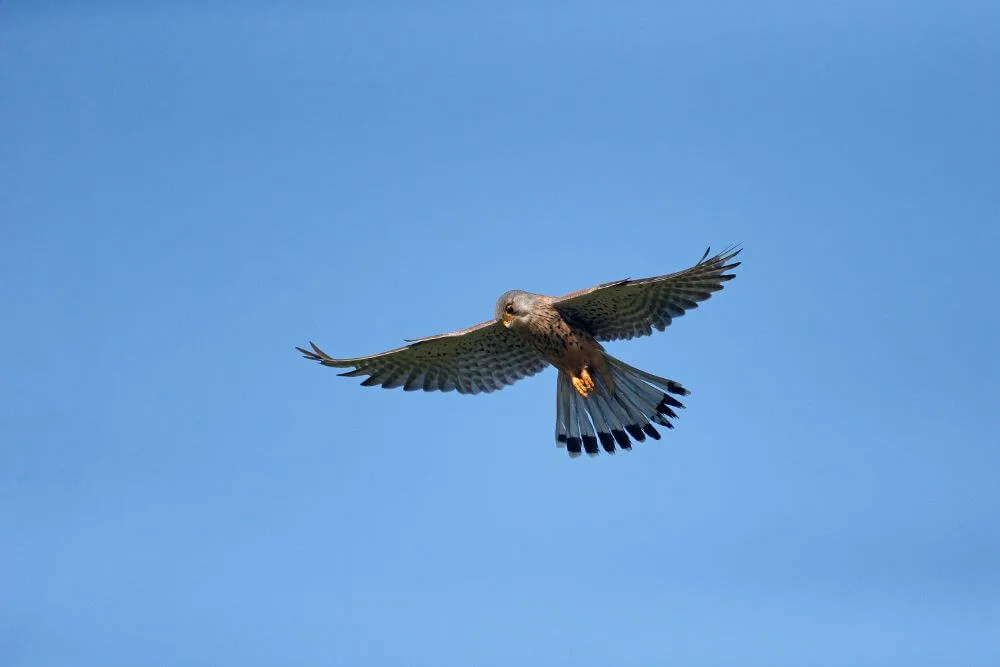
Kestrels have the ability to hover in one place with their head still and tail fanned. This allows the bird to survey the ground below or focus on prey of large insects, small mammals or other birds with its excellent vision. At the same time, the birds are constantly adjusting to the changes in the wind in order to stay in the same place.
In terms of birds of prey, the Kestrel is small, averaging between 32–39 cm (12-15 inches) making it a bit bigger than a feral pigeon. The males are grayish-blue on their heads and tail. One single dark bar is at the end of the tail of the males. Their backs are a reddish chestnut color. Females are brown with more stripes across the tail and more barring above. Both the male and the female have yellow feet.
Like many other birds of prey, Kestrels can see ultraviolet light. This ability is a distinct advantage as it allows the Kestrels to see the scent markers left behind by small mammals that glow in ultraviolet light and track their prey more easily.
Kestrels in Ireland
Kestrels can be found in many different habitat types including woodland, grassland, wetland and even coastal areas. These birds also can be occasionally seen in more urban settings as well.
Merlin
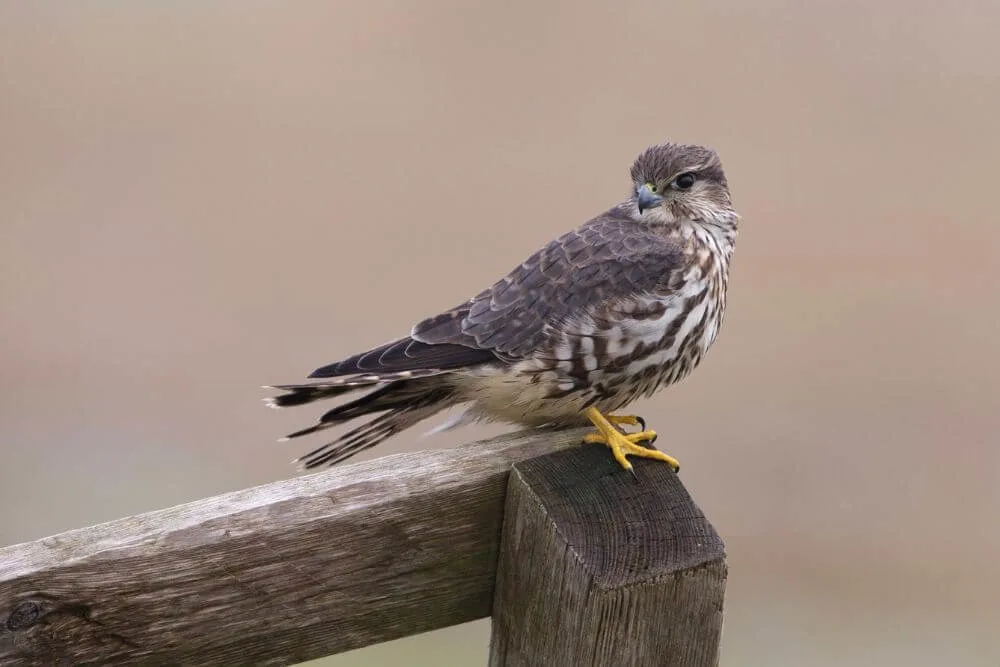
Irish Name: Meirliún
Latin Name: Falco columbarius
Conservation Status: Amber
These small falcons are fearless predators, who are skilled in the art of fast chase.
Merlins tend to fly close to the ground and surprise and scare their prey into the air before performing a fast chase to capture them.
The Merlin is the smallest falcon in Ireland, as well as being the smallest falcon in Europe. It is roughly similar in size to the common blackbird.
Occasionally they can be mistaken for a Peregrine Falcon due to some similarities in their plumage, but one distinct difference is that Merlins do not have the typical mustache that Peregrine Falcons have.
Male Peregrine Falcons are gray above and yellowy-orange white below, while females tend to be brown with some darker streaking below. The tale of the male has one dark band at the end and the female as several bands. Their wings are broad, but end in a distinctive point.
Merlins in Ireland
Merlins in Ireland can be found on the upland bogs during the summer and lower sites during the winter months. The species only rarely breeds in Ireland and is not all that often seen.
Hawks in Ireland
Sparrowhawk Ireland
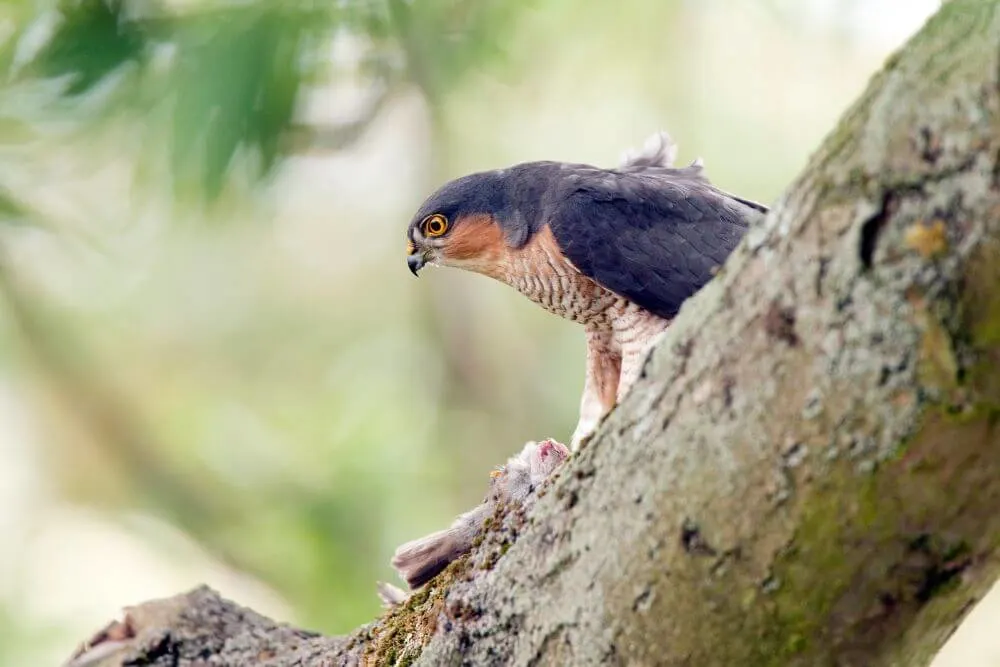
Irish Name: Spioróg
Latin Name: Accipiter Niseis
Conservation Status: Green
Sparrowhawks can be recognised by their smaller size (roughly 30 cm or 12 inches). In flight it is possible to see the rounded wings (typical of hawks) and a long tail.
The underparts are barred on both the male and the female, Males having reddish, chestnut color barring, while the females have greyish ones. The upper parts of the males are blue-grey and the females are generally more brown. Their eyes are a yellow-orange color.
Female sparrowhawks are considerably bigger than the males. The size difference can be as large as 25% in some cases.
These birds have superb hunting abilities that enable them to capture smaller birds including Sparrows (no surprise about the name), Finches, Tits and Starlings. Occasionally, they will also hunt birds even larger than themselves, such as Woodpigeons.
During the breeding season is when the call of the sparrowhawk is most likely heard. It is a strong “cheep” sound.
Sparrowhawk in Ireland
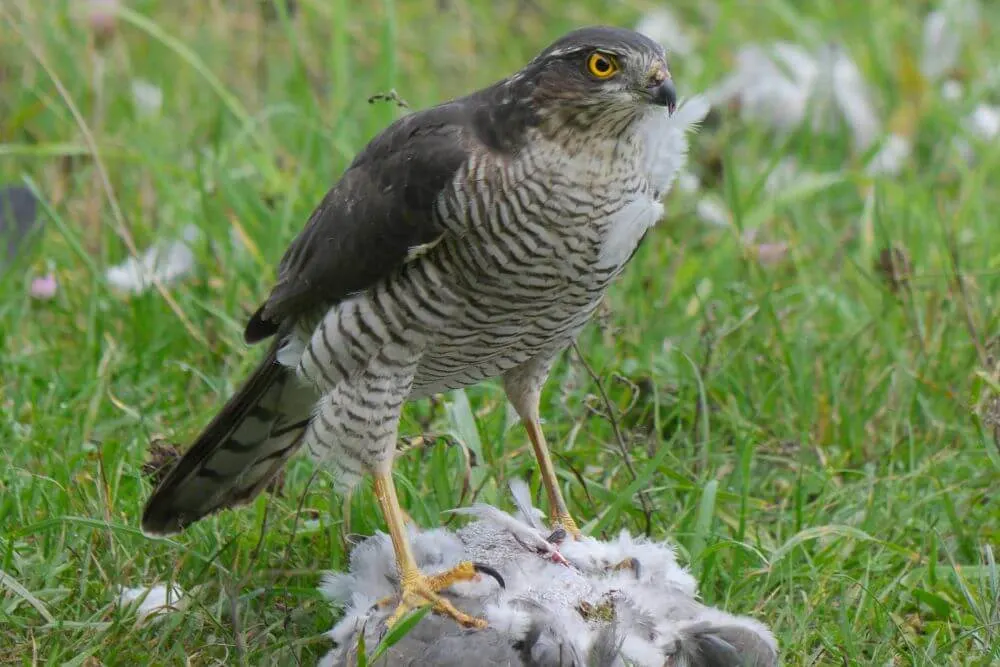
These birds of prey are seen throughout Ireland, but often in woodland areas where the tend to build their nests.
They are most likely found in many different habitats from woodland to farmland to towns and gardens. Occasionally, they try their luck at catching the small garden birds that visit bird feeders in gardens.
Harriers in Ireland
Hen Harrier Ireland
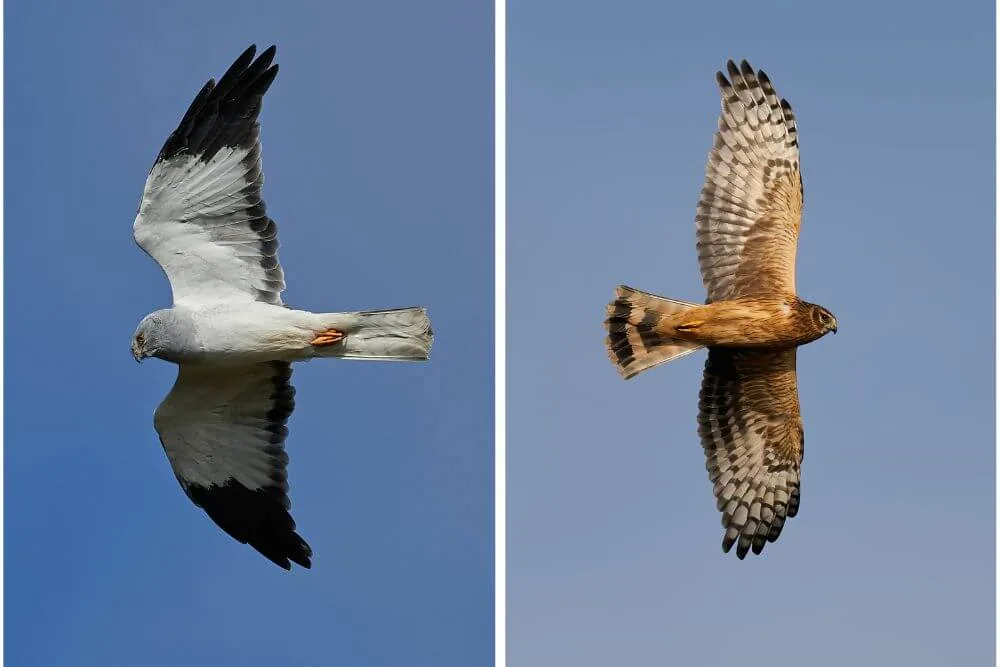
Irish Name: Cromán na gCearc
Latin Name: Circus cyaneus
Conservation Status: Amber
Interestingly, the male and the female Hen Harrier look completely different. Males are a smokey bluey-grey color with black tipped wings and from below they are white. Females have strong barred brown and white plumage below and are mostly brown above. They are considerably larger than the males.
These are very graceful birds and elegant fliers. Males perform a “skydance” to attract a female mate in spring. This is an incredible aerial display of agility and skill.
They also can toss food to each other in mid flight. For an amazing example of the flying abilities of both the male and female Hen Harrier, it is worth checking out this video. (Filmed in Orkney, Scotland).
Hen Harrier in Ireland
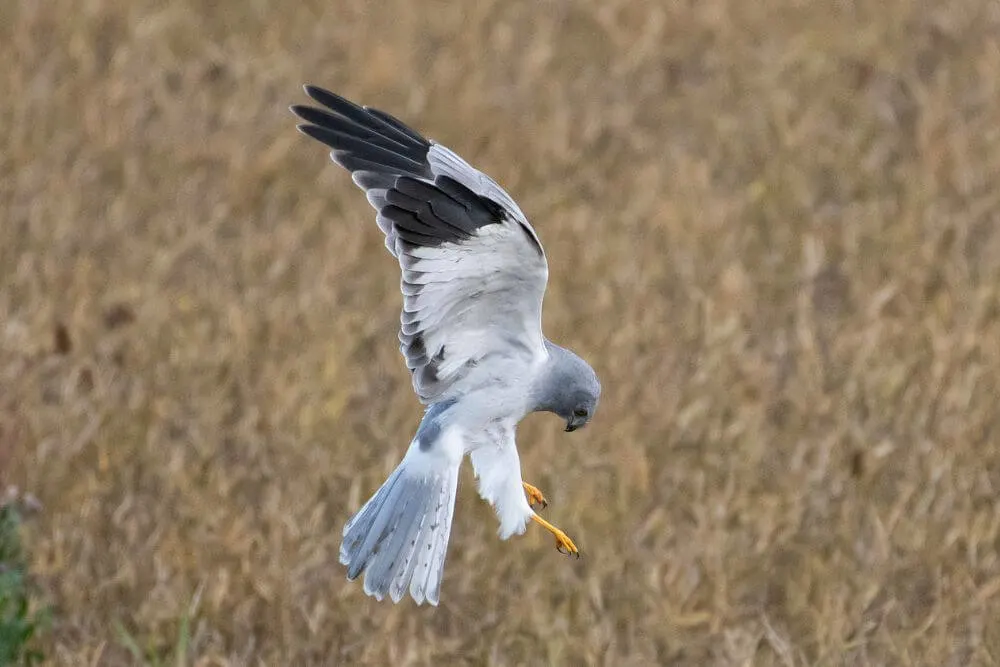
The Hen Harrier is usually found gliding through the skies in the upland areas of Ireland, especially over bogs and farmland areas.
The Marsh Harrier is an occasional summer visitor to Ireland where it is most often found in wetland areas.
Less Common Birds of Prey in Ireland
Common Buzzard Ireland
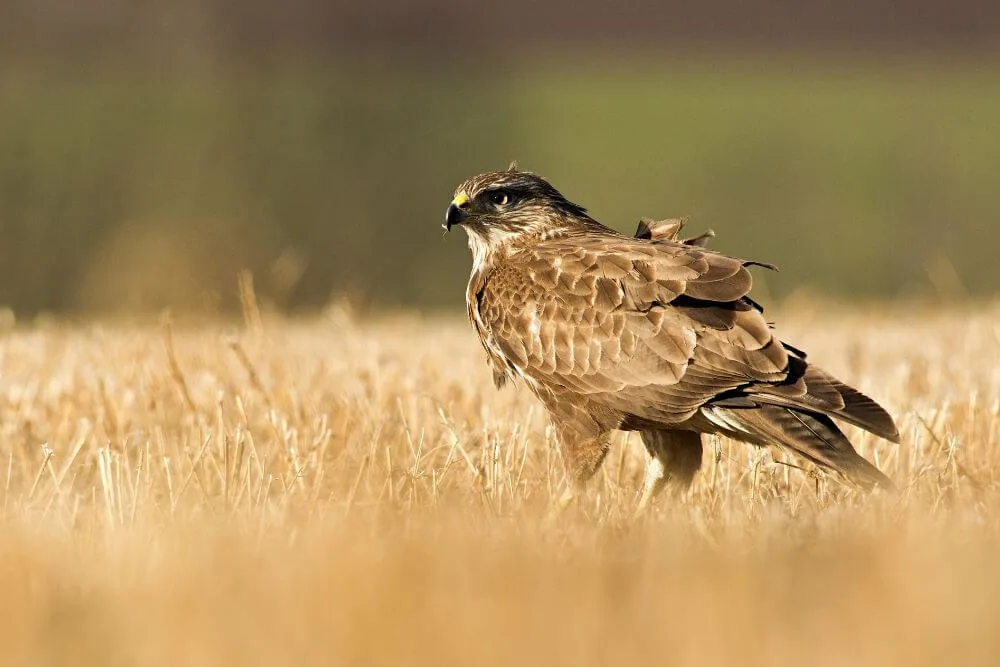
Irish Name: Clamhán
Latin Name: Buteo buteo
Conservation Status: Green
Buzzards are also seen in Ireland and their numbers continue to expand since a ban came into existence in the 1990s which banned the use of strychnine to control rodents. This caused secondary poisoning in the birds.
However, this is not the only challenge that the species has encountered In the past. The Buzzard was once thought to have been widespread around Ireland, but through hunting it became extinct in the late 19th century.
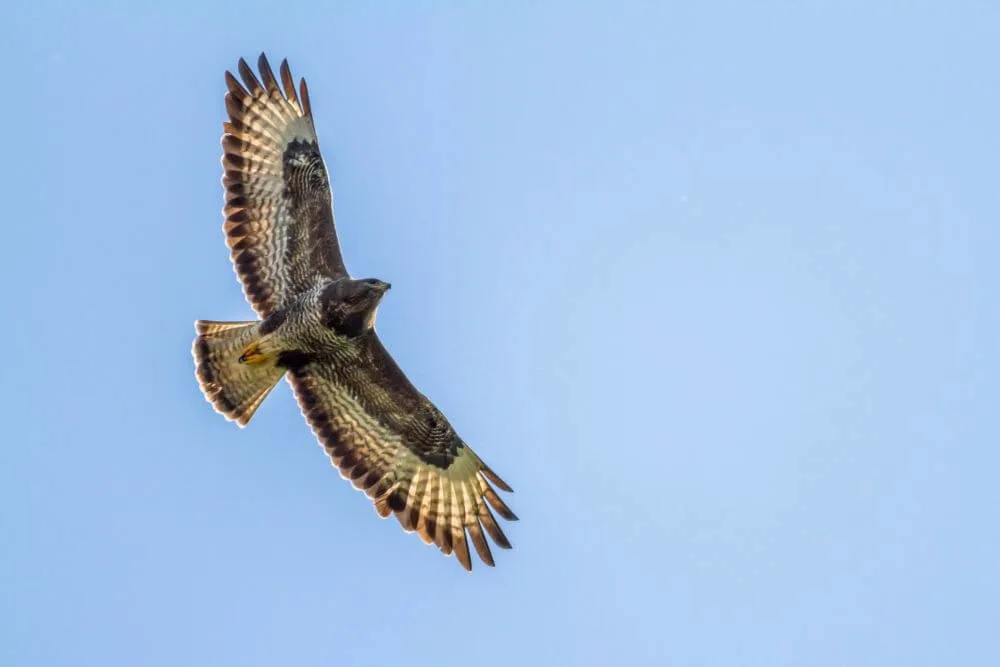
Buzzards range considerably in color. Some are pale shades of brown, while others can be dark brown. Usually the plumage has some barring, which is also visible under the wings. The common buzzard call sounds like “kee ahh”. If you think Buzzards are big, then wait til you see a Golden Eagle, which are roughly about twice as big!
Buzzard in Ireland
From about the 1960s, pairs of Buzzard started breeding again first in some counties in Northern Ireland (Antrim and Down), followed by further expansion of the bird’s range further south.
Golden Eagle Ireland
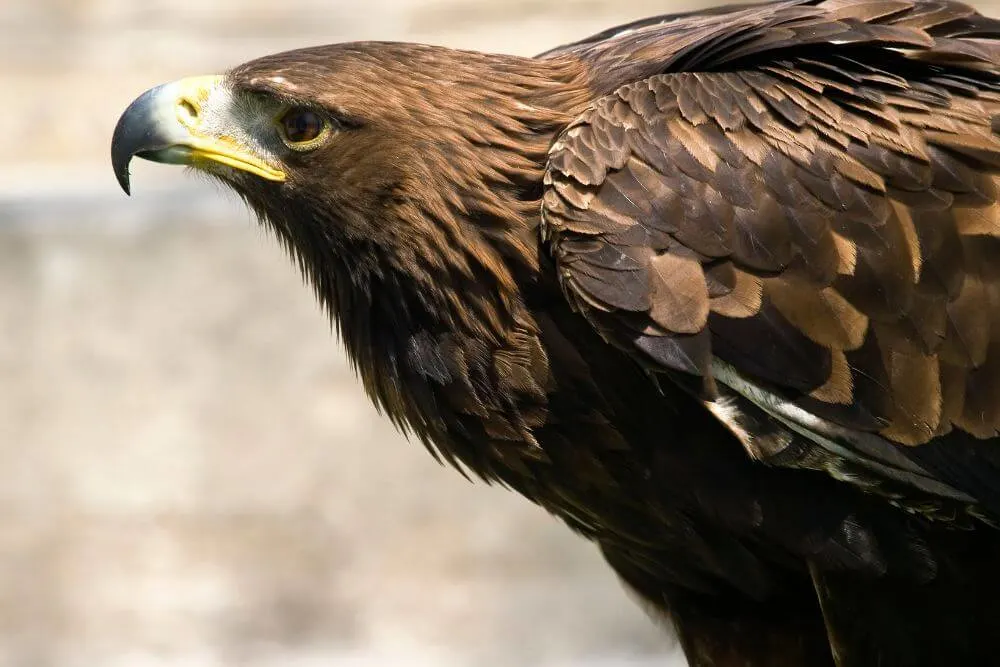
Irish Name: Iolar firéan
Latin Name: Aquila chrysaetos
Conservation Status: Red
Like the Buzzard, the Golden Eagle was found throughout Ireland in the past, but it too has suffered greatly due to hunting.
Adult Golden Eagles are mostly dark brown in color, with a golden head and neck. These large birds have a wingspan of about 2.2 m (ca. 7 feet), making Golden Eagles the second largest bird of prey species in Ireland (after the White Tailed Sea Eagle). Pairs mate for life.
As superb hunters, Golden Eagles are adept at catching bigger larger birds, such as crows, gulls, but also mammals such as rabbits, small foxes and badger cubs.
Interestingly, the Golden Eagle is used as a national symbol in several countries, including Germany.
Golden Eagle in Ireland
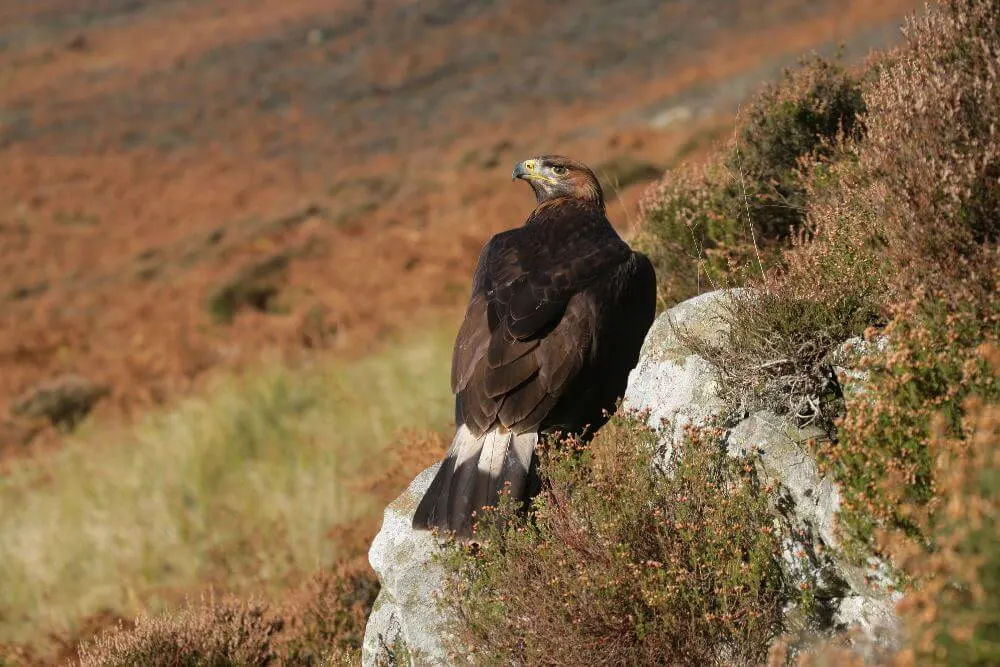
As part of the Millennium Project, birds were reintroduced from Scotland to Dongal and a successful breeding program has been established.
White Tailed Eagle
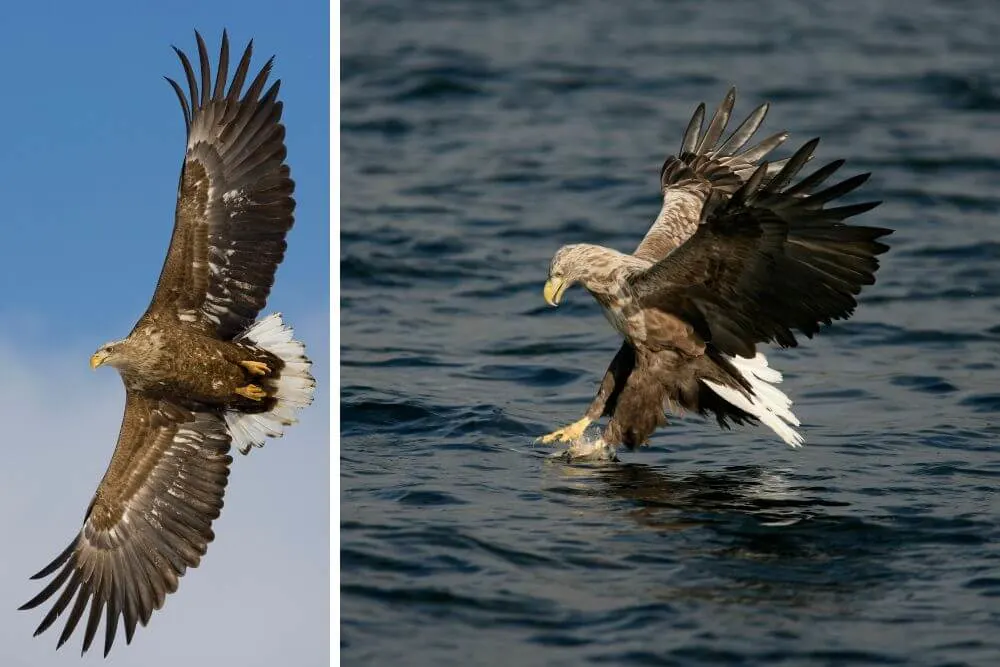
Irish Name: Iolar mara
Latin Name: Haliaeetus albicilla
Conservation Status: Red
The White Tail Eagle or Sea Eagle is a breathtaking bird. The massive wingspan of up to about 2.4 m (ca. 7.8 feet), just lets you imagine how truly massive these predators are.
Like Golden Eagle and Buzzard, the White Tailed Eagle was driven out of Ireland for many years. In the 1970s the first successful reintroductions took place in Scotland from Norwegian chicks.
Based on many of the lessons learned during this process, White Tailed Eagles were reintroduced to Killarney National Park in 2007. The first re-introduction was successful and the second phase of re-introductions occurred between 2020-2022. Like most recent reintroductions, individual birds are wing tagged and satellite tagged to help monitor their progress.
As the name suggests, the tail of these birds is white, their bodies are mostly brown and their heads are lighter in color with a yellow bill.
White Tailed Eagles in Ireland
They can have a large territory of up to about 70 square km (27 square miles) and are found usually near the coast and feeds on carrion, as well as fish, birds and small mammals.
For more information, including the live stream of the White Tailed Eagle based on Garnish Island near Glengarriff can be found here.
Other Birds of Prey found in Ireland
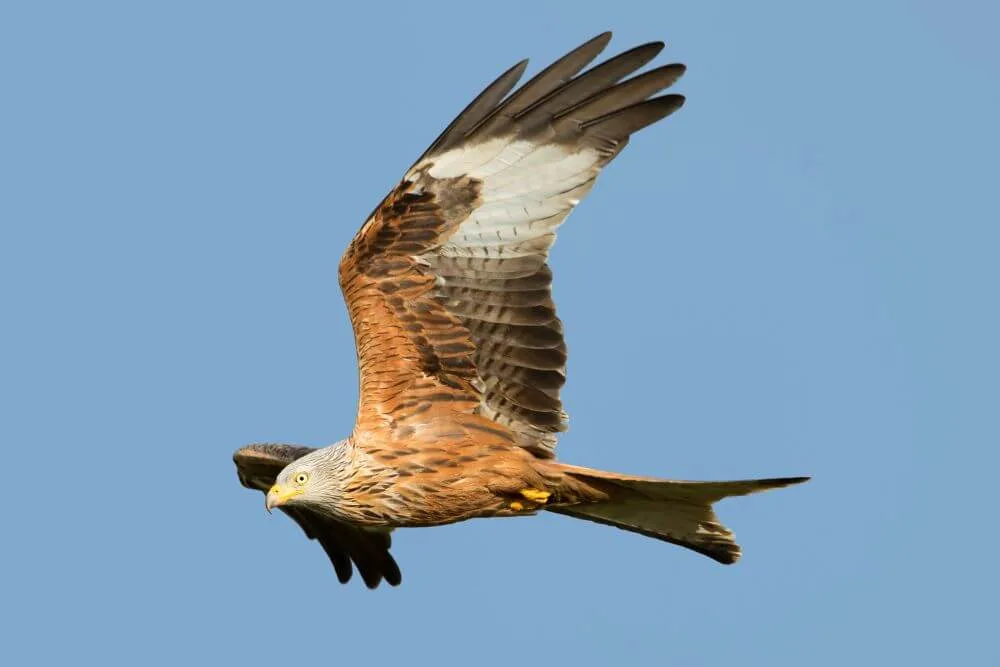
Other birds of prey that are found in Ireland include Red Kites (Milvus milvus). These birds were also eradicated from Ireland and were successfully reintroduced to the east coast of Ireland in a recent two phase program.
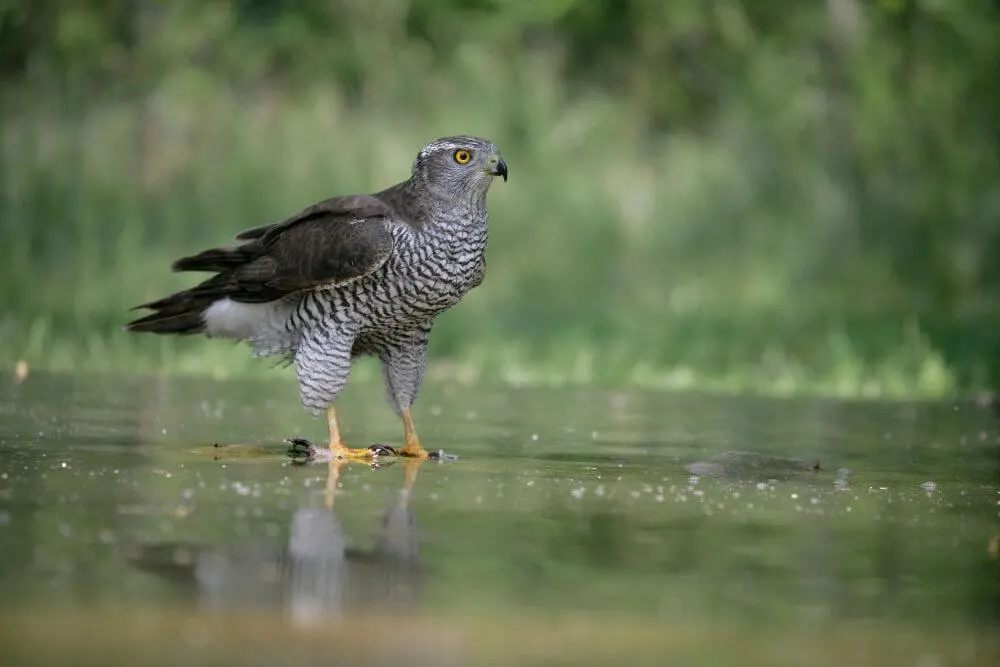
The Goshawk (Accipiter gentilis) is one of the more elusive birds of prey in Ireland and is very difficult to catch a glimpse of. Most of the time, these birds are just passing through and are not resident in Ireland.
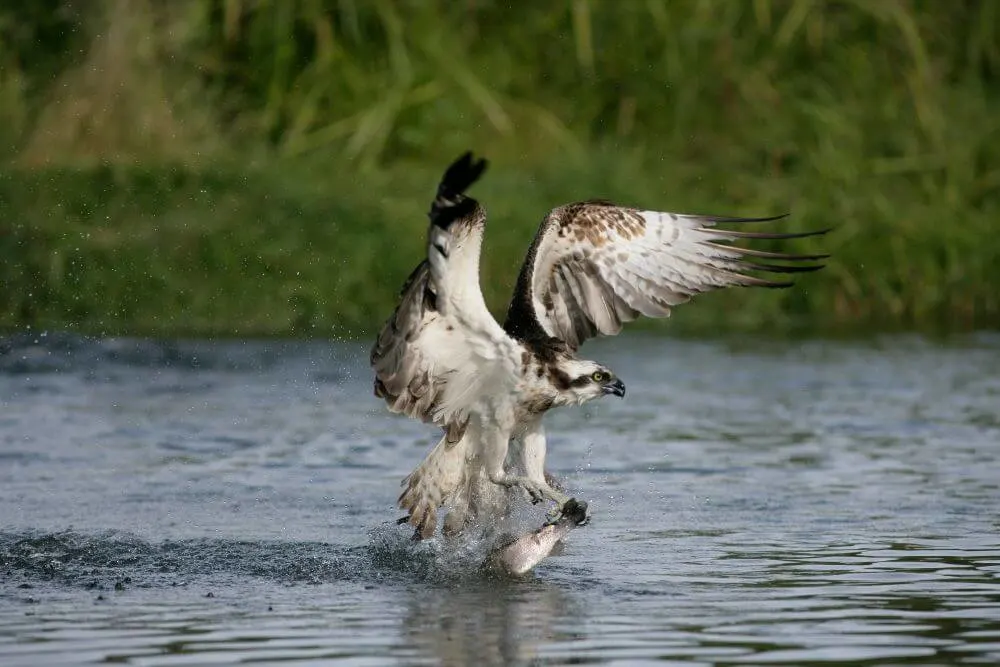
One bird of prey that occasionally spends summer months in Ireland is the Osprey (Pandion haliaetus). They are most likely spotted in wetland or estuary areas (for example in the Swords Estuary in Dublin). A particularly impressive sight is that of an Osprey diving talons first into the water to catch a fish.
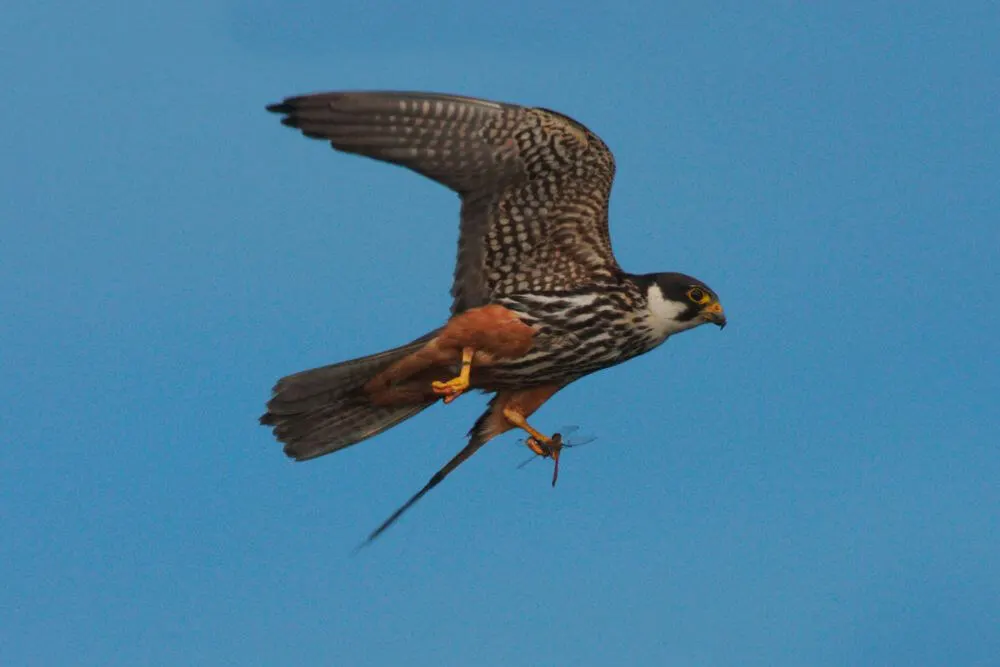
The streamlined speed and skill of the migratory Hobby (Falco subbuteo) is also worth a mention. They are also a little elusive, but well worth keeping an eye out for as their coloring alone is beautiful and somewhat similar to a Peregrine Falcon.
Irish Owls
While the birds of prey above are diurnal (or are active during the day), it is important not to forget the nocturnal birds of prey in Ireland, the owls.
There are three owl species in Ireland:
- Barn Owl
- Long Eared Owl
- Short Eared Owl
Occasionally, the Snowy Owl will also appear as a temporary migrant in Galway, Mayo or Clare during the winter months.
Barn Owl Ireland
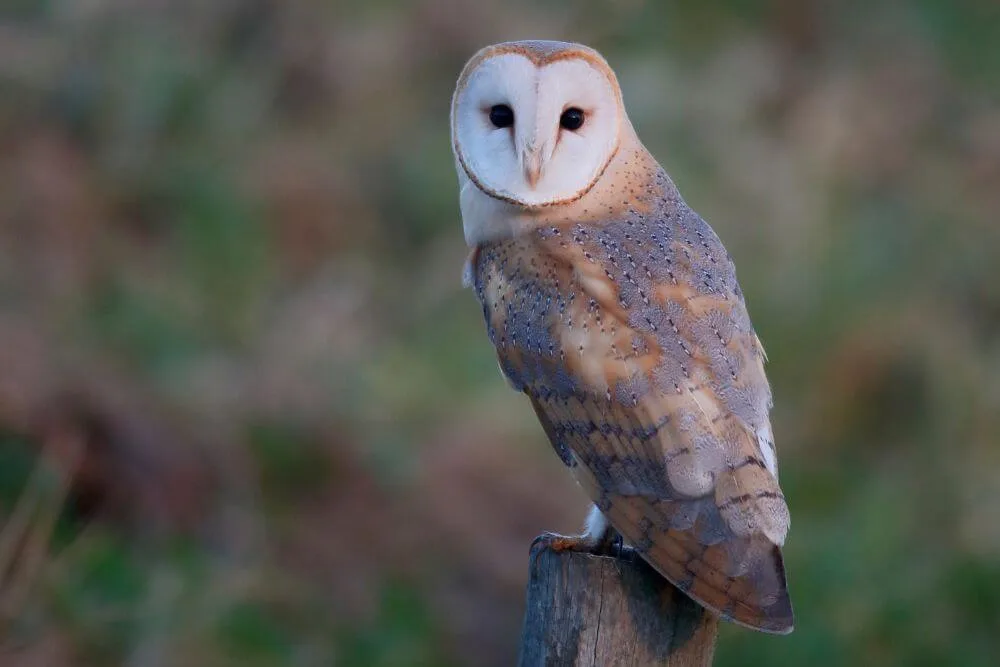
Irish Name: Scréachóg reilige
Latin Name: Tyto alba
Conservation Status: Red
The ghostly figure of a Barn Owl at night, silently swooping through the skies can be a terrifying and amazing sight. It is little wonder that the shriek of the barn owl is thought to have been the origin source for the call of the banshee.
These nocturnal birds have excellent vision and can move almost in complete silence as they launch a surprise attack on their prey of small mammals including shrews, mice and rats as well as the occasional frog. They hunt nearly always at night and are very seldomly seen during the day.
Habitat deterioration, such as limited number of ruins, less suitable farm buildings and sheds, as well as the removal of older trees (some of which may be thought of as posing a safety rise) has helped to reduce the populations of Barn Owl in Ireland. Other challenges that the Barn Owls face are the same as the other birds of prey outlined below.
Barn Owls in Ireland
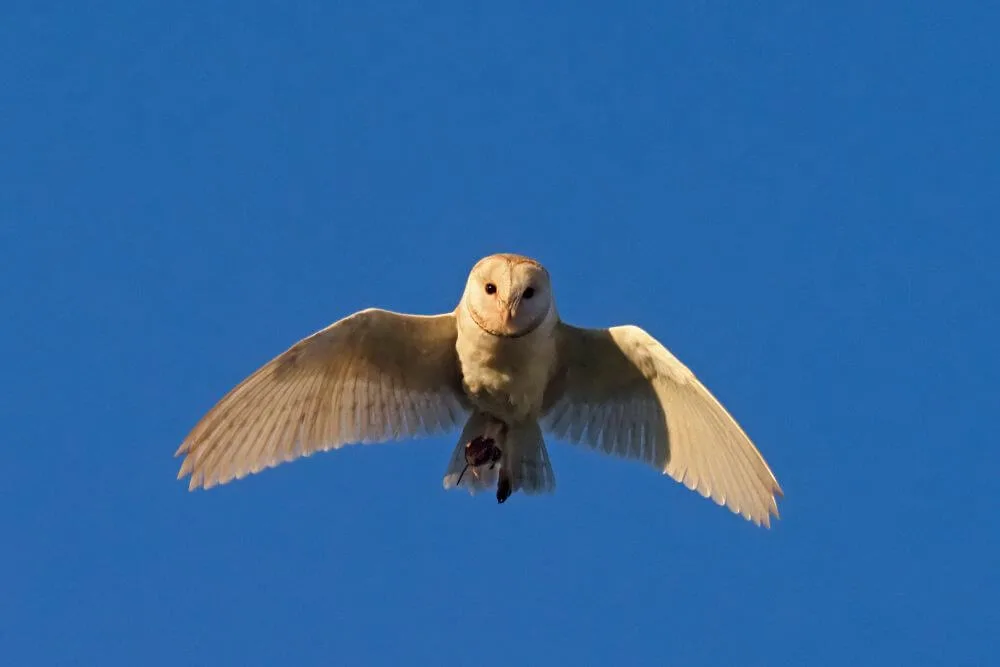
Barn Owls in Ireland are now found mostly in the midlands and south of the country. There is great conservation work being carried out by The Barn Owl Project, which focuses on conservation and rehabilitation of all types of birds of prey in Ireland.
Interesting fact: The Barn Owl has been associated with the famous Irish television program “The Late Late Show” since the show started in 1962. A recent public vote decided that the owl should be called Gabriel in honor of the late host Gay Byrne.
Challenges for birds of prey
These magnificent birds have an important role at the upper end of the food chain in Ireland. However, despite their immense size and expertly adapted hunting skills, these birds must fight against many odds to survive.
Hunting
As mentioned above, many of the larger birds of prey were hunted out of Ireland by the early 20th century. They were seen as a threat to farm animals, especially lambs and no doubt there was also a degree of trophy hunting also taking place.
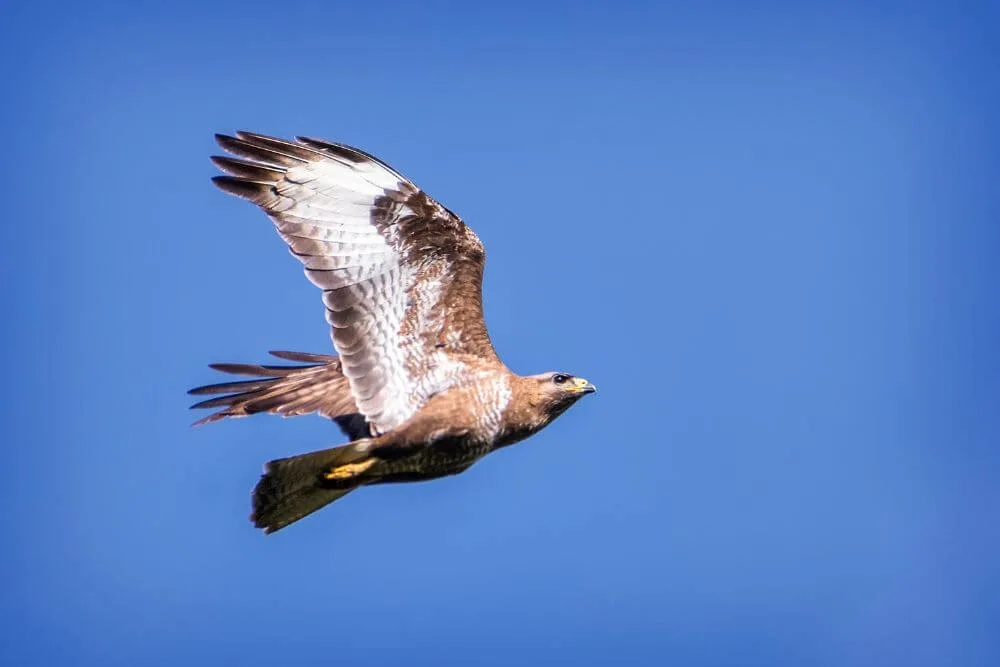
Poisonings
In order to reduce numbers of crows and foxes, farmers have left poison-bait traps on their land for the animals to find and consume. This harmful practice has very detrimental impacts on the wildlife. Through the use of poison bait traps, many birds of prey (along with other wildlife) have been killed as a result of secondary poisoning (ingesting an animal that has been poisoned).
This may not kill the birds or animals straight away, but the consumption is likely to cause internal health issues (such as bleeding), reduce their life-span, feeding and or flying ability (potentially leading to fatal collisions).
In 2010, a ban came into force in Ireland against the legal purchase of poisons used to kill birds and animals. Sadly, deliberate poisonings still occur from time to time with devastating consequences for these protected birds (and other animals). As well as continued education and outreach in communities, convictions and fines are being used to tackle this avoidable issue.
One exception to the poison ban is poison used to kill mice and rats (rodenticide). There is currently no regulation on the use of rodenticide in Ireland and little knowledge of the degree of secondary poisoning in Irish birds of prey.
The Barn Owl Project hopes to tackle this issue. For more information, you can read here.
Climate Change
Climate change impacts all levels of the ecosystem and these birds of prey are not immune either. Adverse weather conditions, increased temperatures, changes in rainfall patterns to mention a few have knock on effects on food availability for these birds of prey.
Additionally, more severe storms can threaten young birds, especially chicks when they are still at a very vulnerable stage and cannot fly or fend for themselves.
Bird Flu (Avian Influenza)
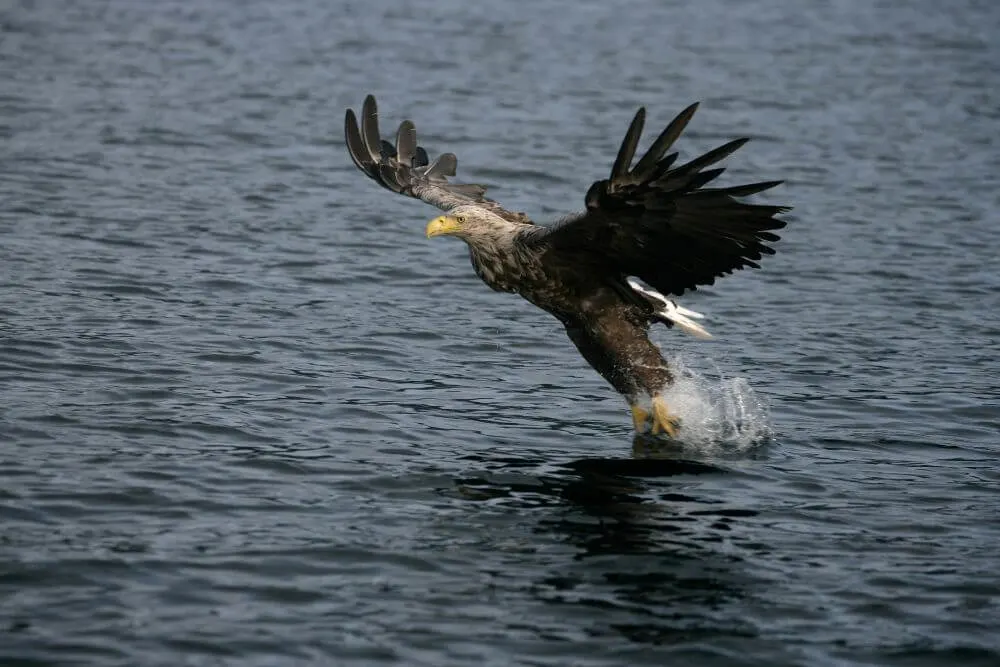
Birds of prey are also susceptible to avian flu or bird flu. Outbreaks, particularly the confirmed outbreaks in seabird colonies in Scotland and England, can quickly work their way up the food chain in Ireland too. For example, White Tailed Sea Eagles prey on waterfowl and sea birds and so are vulnerable.
What to do if you find a dead wild bird: If you do find a dead wild bird in Ireland, please do not touch or go near it. Instead the best advice is to report it (with photos and location) on the Avain Check app released by the Department of Agriculture, Food and the Marine, which is tracking this issue.
Wind Turbines
Renewable wind energy has many benefits, but as with most things there are also downsides. Many wind farms in Ireland have been established in sensitive areas, which are home to birds of prey, such as Hen Harriers. The construction of wind farms, as well as changes that wind turbines have on the landscape can impact species negatively.
As well as the risk of collisions, birds of prey near wind turbine sites also may experience a decline in the number of prey of certain species in the area. Check out a recent study carried out through the University College Cork for more information.
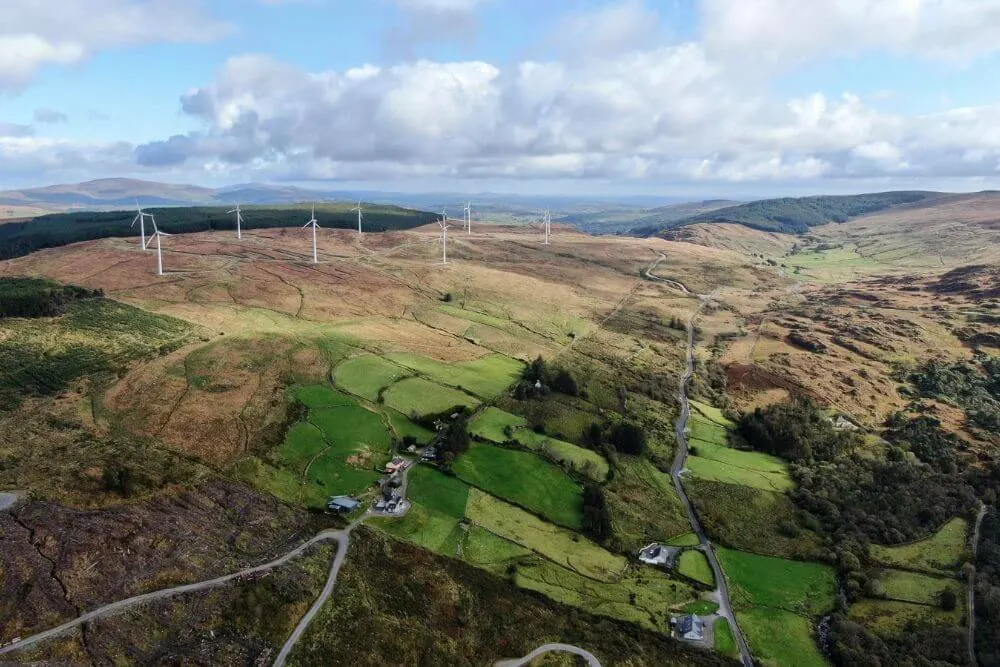
Interactions, Attitudes and Communication
Concern from farmers about the introduction of these large predators is an important issue. These concerns are often related to attacks on animals such as sheep and lambs.
Good communication helps to ensure that all landowners and farmers are able to work together to help conserve these protected birds. Local communities must be brought onboard and their concerns addressed in order to make sure that reintroductions are to be successful.
Some feedback from farmers was even positive, for example, Golden Eagles also have positive impacts as can deter other birds of concern around lambing time, such as gray crows.
There is also a sense of pride that some farmers have when these incredible birds of prey establish and breed on their land.
Additionally, there is also a great interest in these birds and their presence, especially in rural areas can be carefully managed as a tourism incentive for an area.
Irish Bird of Prey FAQ
What is Ireland’s largest bird of prey?
The White Tailed Eagle is Ireland’s largest bird of prey. It has a wingspan of well over 2 meters (over 6.5 feet). The Mute Swan and White Tailed Eagle are tied for being the biggest native birds of Ireland.
What is Ireland’s smallest bird of prey?
The Merlin is the smallest bird of prey resident in Ireland. They are roughly the same size as a blackbird.
What birds of prey are found in Northern Ireland?
Northern Ireland has an impressive selection of birds of prey, which is very similar to the birds of prey found in the Republic of Ireland. The Northern Ireland birds of prey include:
- Peregrine Falcon
- Kestrel, Merlin
- Hobby
- Sparrow Hawk
- Goshawk
- Hen Harrier
- Marsh Harrier
- Common Buzzard
- Golden Eagle
- White Tailed Eagle
- Red Kite
- Barn Owl
- Long-Eared Owl
- Short Eared Owl
More information about the birds of prey in Britain can be found on The Wildlife Trust.
Where to see birds of prey in Ireland in the Wild?
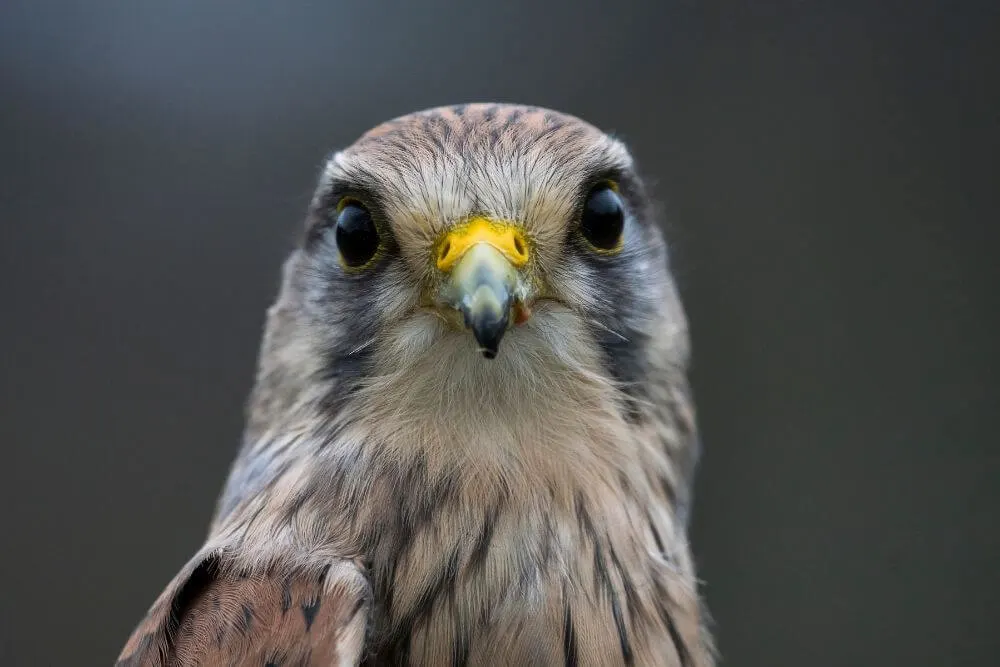
Some of the best chances of spotting Golden Eagles is in County Donegal, White Tailed Eagles are mostly found around the west coast, especially in Glengarriff, Lough Derg and Killarney, but are also found in the Midlands during the winter months. Red Kites are found along the east coast in County Down, County Dublin and County Wicklow. Other birds such as the Kestrel, can be seen hovering in the air across much of the countryside.
If you are not lucky enough to spot some when you are out and about in nature, there are also opportunities to view the birds up close in centers, such as the National Bird of Prey Centre. This center for birds of prey in Wicklow offers people the option of specialized informative walking tours focusing on one or more bird of prey species, where you can see the Irish birds of prey in flight.
Other options include:
- Birds of Prey Sligo (Eagles Flying)
This is home to the Irish Raptor Research Centre, where in addition to watching the birds of prey demonstration, there is also an accredited petting zoo.
- Falconry Wexford (Falconry Ireland) .
In the Wexford birds of prey center, there are options for both group and individual falconry experience tours to suit your requirements.
Where can I find out more information about native Irish Birds?
Birdwatch Ireland, The Irish Wildlife Trust and The Barn Owl Project are all excellent sources of information if you want to know more about the birds of Ireland and what you can do to help them.
Eric Dempsey a leading expert on Irish birds and is the author of several highly recommendable books on the subject, including Birdwatching in Ireland and Finding Birds in Ireland. These are great for Irish bird of prey identification.
The observant of you may also have seen that many of the beautiful images used in this article are by the expert nature photographer Mike Lane. Check out more of his fantastic photography, as well as tips for wildlife photography on his website.
Where can I find Irish birds of prey sounds?
This website is a very useful searchable resource for bird calls (not just from Ireland). Many of the Irish bird calls have been submitted by Seán Ronayne of Irish Wildlife Sounds. These also include the Irish birds of prey sounds.
For some more interesting information about Ireland’s flora and fauna, why not check out the unique biodiversity in the Burren.

(Irish Nature Expert and Celtic Enthusiast from Ireland)
Emer Walker, founder of LetsGoIreland.com, is a Cork native with profound expertise in Irish nature and ecology. Holding a PhD in Restoration Ecology and backed by extensive research in ecological sciences, she’s delved deep into Ireland’s natural wonders, from its rugged landscapes to its serene beaches. Emer’s passion also encompasses Celtic art and traditions. As a true authority on Ireland’s natural and cultural heritage, she invites readers through LetsGoIreland.com to immerse themselves in the authentic Irish experience.
